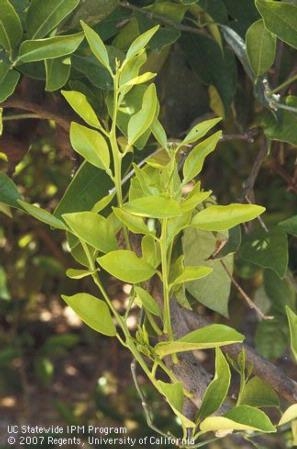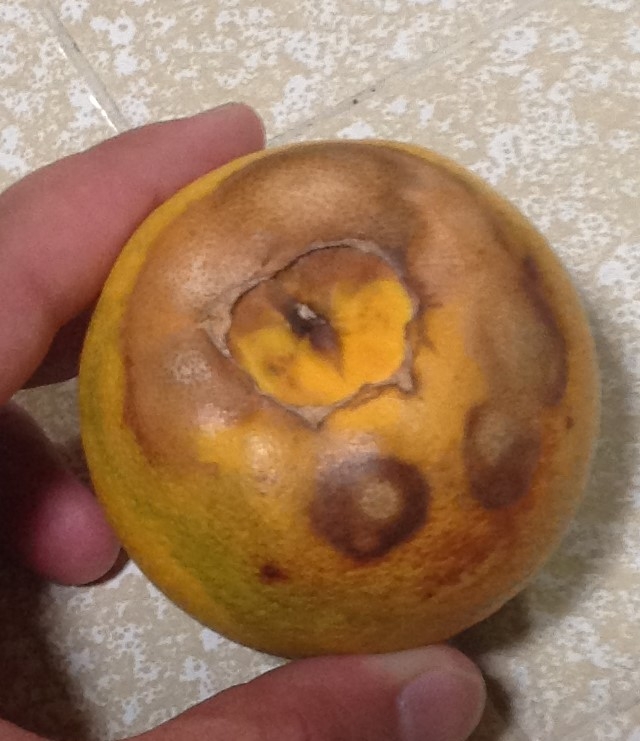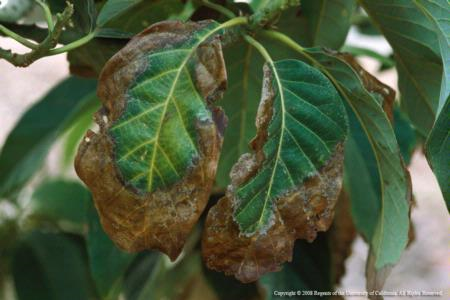
Posts Tagged: tip burn
Avocado Body Rots Are Showing Up Now
Get ready for more rotting avocado fruit if you have leaf blight showing up in your tree canopy. The fungal spores (one of the Botryosphaerias we once lumped as Dothiorella) that create the infection spread in an irregular pattern over the leaf and down the stem (then called “stem blight”). This is often confused with salt or tip burn. The two conditions are caused by the same problem, water and or salt stress. However, in the case of leaf blight, this is a pathogen that can pass to neighboring fruit and begin the process of rot. This starts happening when the fruit starts ripening and softening, so it's often not seen in the orchard, but the packhouse or in the market.
Control is basically gaining control over the soil moisture and salinity in the root zone and when the leaf blight starts showing up in the canopy, cutting as much out back to green tissue as is economically possible.
Leaf blights from this group of fungi have also been reported as infecting other fruits, such as citrus, apple, peach and grape among others. The solution is the same - water right and cut the stuff out when and if it shows up.
Photos:
Body rots
Rot spreading to flesh
Leaf Blight

avocado body rot1

avocado body rot2

Avocado leaf blight
Drought Induced Problems in Our Orchards
Drought Induced Problems in Our Orchards
Abiotic disorders are plant problems that are non-infective. They are not caused by an organism, but through their damage, they may bring on damage caused by organisms. Think of a tree hit by lightning or a tractor. The damage breaches the protective bark which allows fungi to start working on the damaged area, eventually leading to a decayed trunk. It was the mechanical damage, though that set the process in motion.
Too much or too little water can also predispose a plant to disease. Think of Phytophthora root rot or even asphyxiation that can come from waterlogging or too frequent irrigations.
Salinity Effects from Lack of Water
Lack of water and especially sufficient rainfall can lead to salinity and specific salts like boron, sodium and chloride accumulating in the root zone. This happens from a lack of leaching that removes native soil salts from the root zone or the salts from the previous salt-laden irrigation from the root zone. These salts cause their own kind of damage, but they can also predispose a tree to disorders, disease and invertebrate (insect and mite) damage.
Lack of water and salt accumulation act in a similar fashion. Soil salt acts in competition with roots for water. The more soil salt, the harder a tree needs to pull on water to get what it needs. The first symptom of lack of water or salt accumulation may be an initial dropping of the leaves. If this condition is more persistent, though we start to see what is called “tip burn” or “salt damage”. Southern California is tremendously dependent on rainfall to clean up irrigation salts, and when rain is lacking, irrigation must be relied on to do the leaching
As the lack of leaching advances (lack of rainfall and sufficient irrigation leaching) the canopy thins from leaf drop, exposing fruit to sunburn and fruit shriveling.
Leaf drop and fruit shriveling in avocado.
In the case of sensitive citrus varieties like mandarins, water stress can lead to a pithy core with darker colored seeds, almost as if the fruit had matured too long on the tree.
Total salinity plays an important factor in plant disorder, but also the specific salts. These salts accumulate in the older leaves, and cause characteristic symptoms that are characteristic in most trees. Boron will appear on older leaves, causing an initial terminal yellowing in the leaf that gradually turns to a tip burn.
Often times it is hard to distinguish between chloride, sodium and total salinity damage. It is somewhat a moot point, since the method to control all of them is the same – increased leaching. There is no amendment or fertilizer that can be applied that will correct this problem. The damage symptoms do not go away until the leaf drops and a new one replaces it. By that time hopefully rain and/or a more efficient irrigation program has been put in place.
The Impact of Drought on Nutrient Deficiencies
Salinity and drought stress can also lead to mineral deficiencies. This is either due to the lack of water movement carrying nutrients or to direct completion for nutrients. A common deficiency for drought stressed plants is nitrogen deficiency from lack of water entraining that nutrient into the plant.
This usually starts out in the older tissue and gradually spreads to the younger tissue in more advanced cases.
The salts in the root zone can also lead to competition for uptake of other nutrients like calcium and potassium. Apples and tomatoes are famous for blossom end rot when calcium uptake is low, but we have also seen it in citrus. Low calcium in avocado, and many other fruits, leads to lower shelf life. Sodium and boron accumulation in the root zone can lead to induced calcium deficiencies and increased sodium can also further lead to potassium deficiencies. Leaching can help remove these competitive elements.
Drought Effect on Tree Disease
Drought and salt stress can also lead to disease, but in many cases once the problem has been dealt with the disease symptoms slowly disappear. They are secondary pathogens and unless it is a young tree (under three years of age) or one blighted with a more aggressive disease, the disease condition is not fatal. Often times, in the best of years, on hilly ground these diseases might be seen where water pressure is lowest or there are broken or clogged emitters. The symptoms are many – leaf blights, cankers, dieback, gummosis – but they are all caused by decomposing fungi that are found in the decaying material found in orchards, especially in the naturally occurring avocado mulch or artificially mulched orchards. Many of these fungi are related Botryosphaerias, but we once lumped then all under the fungus Dothiorella. These decay fungi will go to all manner of plant species, from citrus to roses to Brazilian pepper.
Another secondary pathogen that clears up as soon as the stress is relieved is bacterial canker in avocado. These ugly cankers form white crusted circles that ooze sap, but when the tree is healthy again, the cankers dry up with a little bark flap where the canker had been.
Drought Effect on Pests
Water/salt stress also makes trees more susceptible to insect and mite attack. Mites are often predated by predacious mites, and when there are dusty situations, they can't do their jobs efficiently and mites can get out of hand. Mite damage on leaves is often noted in well irrigated orchards along dusty picking rows
Many borers are attracted to water stressed trees and it is possible that the Polyphagous and Kuroshio Shot Hole Borers are more attracted to those trees.
And then we have conditions like Valencia rind stain that also appears in other citrus varieties. We know it will show up in water stressed trees, but we aren't sure what the mechanism that causes this rind breakdown just at color break. Could it be from thrips attracted to the stressed tree or a nutrient imbalance, it's not clear?
Water and salt stress can have all manner of effects on tree growth. It should lead to smaller trees, smaller crops and smaller fruit. The only way to manage this condition is through irrigation management. Using all the tools available, such as CIMIS, soil probes, soil sensors, your eyes, etc. and good quality available water are the way to improve management of the orchard to avoid these problems.
Scroll down for Images
Tip Burn, notice sun burn bottom right hand fruit
Endoxerosis with dried out core
Boron toxicity
Nitrogen deficiency
Blossom end rot
Potassium deficiency
Bot gumming in lemon
Black Streak in Avocado
Bacterial Canker
Citrus red mite
Polyphagous Shot Hole Borer damage on avocado
Valencia Rind Stain

avocado drought canopy

nitrogen deficiency

endoxerosis 4

boron toxicity citrus 1

blossom end rot lemon

potassium deficiency avocado

gumming dothiorella

avocado black streak 1

bacterial canker avocado

citrus red mite

PSHB damage
Avocados and Salts
Some call it tip burn which is often what you see on an avocado as it goes into flowering. The areas where avocado are grown typically have a lot of salts in the water, but also specific salts like sodium and chloride. Over the irrigation season (which is all year long there is little or no rain), the salts in the water/soil are taken up by the tree. In adequate rainfall years, there is enough water to leach those accumulated salts from the root system. When we go for several years with low rainfall and we keep irrigating with the poor quality irrigation water, the trees develop die back at the tips and is conditions worsen more and more of the leaf is called. This can get to the point where you can not call it die back any longer. It's called leaf drop. I've recently seen a number of orchards that are completely defoliated. No leaves. We have had a number of homeowner calls asking what the problem is and what they can do about it. The damage is done and those leaves are not coming back. It's possible to reduce the damage if one acts early on by applying more water than is usually applied to aid the leaching process, but if it is poor quality water, there will still be damage, but possibly not defoliation. With high priced water or where water is being rationed, many growers and homeowners do not have themake the option of putting on the excess water. There is no chemical or equipment that is going to make the situation better. When you trees defoliating, you want to cut out those that are diseased or you know have been poor producers and put what water you have on the remaining trees in better condition.
This advice is good for other evergreen tree crops like citrus, although they are not as sensitive as avocado. Avocado is an indication of how bad it really is.

avocado chloride damage
Avocados Looking Grim this Time of Year
I've been getting calls and have gone out to see several avocado orchards in the Ventura/Santa Barbara area and the comments are that the trees look worse this year than they normally do. When I see the trees, it's clear that they don't look in the best shape. This time of year, when there are old leaves that have accumulated salt all through the irrigation period and the trees are getting ready to flower, the leaves just don't have much energy. Also, two years of drought with no rain, means that salts have probably accumulated more by this time of year, than in a year when we do have “normal” rain to leach the soil. The accumulated salts can lead to water stress which also brings on stem and leaf blight, along with salt burn. With the bicarbonates in the water, the pH may have rise as well, inducing some iron chlorosis. Compounding the leaf damage is some frost burn, which was not cold enough to kill the leaves. Any dead tissue, also makes the leaves look more ratty, because with Santa Ana winds earlier, those dead areas have often blown out, making them look like they have been nibbled on by insects. Further adding to the stress was a huge crop year that put a lot of stress on the tress. When clearing the leaves to look at roots, it has often been hard to find viable roots. All these stresses are going to make the trees more susceptible to root rot. So it's going to be necessary for growers to keep their eyes out for further disease symptoms and to be ready to treat with phosphites when the soil warms up enough for the roots to start growing again.

avocado leaf necrosis
When the Rains Don't Do Their Thing
"We don't need to irrigate, it's winter." This is a commonly held idea, and many years it is true. Adequately timed rains will often meet the needs of avocado trees during the winter period, and in times like last year, even satisfy much of the spring requirement. And the calls are coming in – “What’s wrong with my trees, they have all these brown leaves?”. This from San Diego to San Luis Obispo.
In a low rainfall year, irrigation can be as necessary as at other times of the year. This is because a subtropical evergreen like avocado continues to use water regardless of rainfall patterns. At the time of writing this article in March, we have had a scant 4 inches in Ventura and this is on top of a low rainfall year in 2011-12. Rain is necessary to leach the salts that have accumulated from the last irrigation season.
The driving forces for plant water use are light intensity, wind and relative humidity, as well as temperature. Remember how cold, dry winds can dry your skin or freeze-dry backpack food. Even during the winter, the trees are quite capable of losing large amounts of water with clear skies and cold winds.
Dry Santa Ana conditions are also more common in winter than in the past. This winter, a time of drought, I went out to see an orchard to evaluate it for pruning. On arrival, my first concern was for the water stress in the trees. The grower, however, was unconcerned. The trees had been dutifully irrigated the previous Friday. But over the weekend, a Santa Ana had blown for three days and completely dried the soil in the top 10 inches. Digging around the roots convinced the grower of water stress. Do not take irrigation for granted.
Contributing to the problem is the determination of what amount of rainfall is effective. Effective rainfall is defined as the amount of water that is retained in the root zone after rain. Avocados, especially on shallow soils, do not have much of a root zone. Most soils can be expected to hold about 2 inches of available water in the top 2 feet, less the more sandy, more the more heavy.
If rainfall exceeds the holding capacity within the root zone, it is lost to the plant. Just imagine if all the year's expected rain fell during one storm. It would not be long before irrigation would be required with no more rain coming. The extra water may, however, perform the all-necessary function of leaching accumulated salts from the root zone. When the rain gauge says that 2 inches fell, it is quite possible that all that rain will not be available to the tree. This also goes for the quarter inch storms we get that do not even make it through the leaf litter. It is not effective rainfall, even though it may wash the persea mite off the leaves.
One of the best ways to assess the effectiveness of rainfall within the root zone is with tensiometers. These trusty instruments are most commonly used to schedule irrigations. A good rainfall should return the 8- and 18-inch depth gauges to close to 0 cbars. This will tell you whether the rain thoroughly wetted the root zone. It will not tell you how much may have passed through the root zone, however.
If you are using soil sampling to assess the depth of rain infiltration, simply squeezing a handful of soil can help. Regardless of soil texture, a wetted soil will form a ball or cast when thoroughly wetted. Water moves as a front through the soil. After a rain, take soil samples with depth to find where the potential to form a ball abruptly ends. This will tell you the depth of effective rain.
How well a soil holds together can also be an indication of when to irrigate. Even a sandy loam texture will retain a ball that does not hold together well when there is still adequate moisture for the tree. The possibility of forming a ball decreases with water content. When visible cracking of a soil ball is obvious, it is time to irrigate.
Winter irrigation is something we do not commonly perform, but in low rainfall years it is an activity we need to consider, especially for controlling the salts that accumulate from our previous irrigation season.

Copy of avocado irrigation
